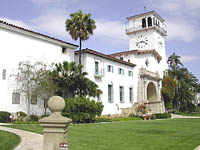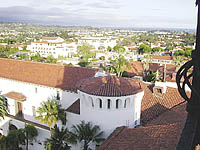|
From Seismic Event to Spanish Style
A Look at the 2003 California Preservation Conference in
Santa Barbara
By David Marshall
 The Santa Barbara County Courthouse, 1929.
|
 View from atop the County Courthouse toward the harbor.
|
On June 29, 1925 at 6:44am a magnitude 6.3 earthquake shook up sleepy Santa Barbara. Wood-framed houses rode it out, but most of the city's commercial buildings didn't fare so well. Along State Street, in the center of downtown, the rubble from brick buildings was so thick that cars couldn't drive the streets. Several hotels partially collapsed while other buildings were completely leveled. The nearby Sheffield Dam ruptured, letting loose a wall of water all the way to the ocean. Thirteen people died and many more were injured.
Out of the rubble grew present-day Santa Barbara, or "The American Riviera" as some call it. Ironically, it was the deadly earthquake of 1925 that, more than any other factor, gave birth to Santa Barbara's distinctive style. This event led to the wholesale adoption of the Spanish Revival architectural style, which was peaking in popularity at the time. City leaders seized the opportunity that the earthquake provided and instituted strict building codes and planning guidelines that remain to this day.
Today, Santa Barbara is a well-known harborside tourist destination with multimillion-dollar homes and a strong legacy of historic preservation. It is against this backdrop that the 2003 California Preservation Conference took place from April 24th through 27th. The California Preservation Foundation (CPF) held the annual conference, subtitled "A Blueprint for Preservation
Since I was SOHO's represenative board member in attendance I attempted to pack my four days with tours, workshops, seminars, and pasta dishes. I decided that the best way to get acquainted with Santa Barbara was by going on the Historic Architectural Uptown Walking Tour. It was a three hour tour... a three hour tour... The weather was perfect and our group walked State Street and viewed many commercial, municipal, and religious structures. The next day I took another walking tour, this time focusing on alternative building code methods for historic structures. We visited the tallest building in Santa Barbara, which is the restored Granada Theatre, and toured the San Marcos Building and the Trinity Church, both of which were seriously damaged in the 1925 earthquake and later reconstructed.
The highlight of both tours was discovering the countless passages, paseos, and courtyards that are hidden in the mid-block gaps between historic commercial buildings. Bubbling fountains, flowering vines, and imaginative (yet restrained) public art fill these spaces that provide shoppers and residents with shade and relief from the automobile. They don't tolerate strip malls in Santa Barbara.
Some may consider Santa Barbara's enforcement of strict design guidelines heavy-handed and even un-American, but it's hard to argue with the results. Because the politicians and planners are strong-willed and consistent, everyone seems to be on the same page. If you don't love Spanish Revival, Mission Revival, or Moorish style architecture, this isn't the town for you. One look at the McDonalds restaurant on State Street -- with a carved wood sign less than two feet square -- and it's clear that Santa Barbara is a different place. The most shocking thing I saw in Santa Barbara was the downtown RiteAid drugstore that was not an eyesore. I swear. RiteAid even had a modest-sized sign made from brass letters. If I were to name the ten ugliest buildings in San Diego, RiteAid drugstores would probably account for at least half of the list. If Santa Barbara can control the RiteAid monster, they are clearly way ahead of the game.
One of the largest and most spectacular buildings in Santa Barbara is the County Courthouse, completed in 1929. The Spanish Revival structure resembles a castle, both inside and out. The courthouse shares its large site with a beautiful public park that gives the monumental architecture an ideal backdrop. The view from the top of the clock tower is amazing, with red clay tile as far as the eye can see. The courthouse was the location of the opening night reception and made for a memorable venue.
The Radisson Hotel was the site for the seminars and, although it was less enchanting than the Courthouse, the hotel sits only 500 feet from the sandy beaches of the harbor. The first seminar I attended was Evaluation and Designation of "Modern" Resources. The label "Modern" generally refers to buildings constructed between 1945 and 1965. There's a growing international movement to save buildings of the Modern era. The successful fight to save the first McDonalds in Downey, built in 1953, was one of the first times that the historic merits of post-war architecture were recognized.
Some of the rapidly disappearing reminders of the Modern era include bowling alleys, car washes, motels, theaters, and cocktail lounges. Adventurous styles such as Polynesian/Tiki, Streamline Moderne, Googie, and Roadside Vernacular were some of the popular themes of the Modern era. The fight to save Modern buildings from the wrecking ball is being led by the Los Angeles Conservancy and an international organization called "DoCoMoMo" which stands for Documentation and Conservation of Buildings, Sites and Neighborhoods of the Modern Movement. While their efforts are worthwhile and long overdue, it's scary when buildings constructed in my lifetime start being designated as "historic."
Another seminar I attended was called "Design Guidelines for Additions and Infill" and it proved to be an enlightening and controversial topic. The session was divided into a dozen small groups who each functioned like design review committees. Several addition and infill projects were presented and each committee would debate their merits in front of the entire group. Projects ranged from a perforated steel-skinned high-rise in San Francisco to a modest housing development in San Jose. San Diego's controversial museum addition to the (continued on next page) downtown Santa Fe Depot was also presented. One of the moderators shared a quote from famed architect Robert Venturi that was appropriate for our topic. Venturi once said "We hate the architecture of our fathers, but we love the architecture of our grandfathers." Disagreements over what constituted appropriate additions to historic buildings led to several lively exchanges � and no easy answers.
From a personal standpoint, the most enjoyable event of the conference took place on Friday night. That's when the annual "Three-Minute Success Stories" were presented in the historic Veteran's Memorial Building. The popular CPF event calls for presentations and dramatizations of successful (or at least entertaining) stories from the preservation field. This year nine skits were featured, including one called "Honey, I Shrunk the Warehouse" presented by members of the firm Architect Milford Wayne Donaldson, FAIA, of which I'm a member. Tom Neary of Morley Builders joined us in a slapstick re-telling of the unorthodox restoration of the Western Metal Building as part of the new Padres ballpark. For three brief minutes, we were the funniest preservationists on the planet.
Photos by David Marshall
|
MORE FROM THIS ISSUE
Adding to the Controversy
A Salute to Our Volunteers
Announcing San Diego's First Modernism Weekend
San Diego Modernism Weekend
Julius Shulman
Vintage Trailer Show Rolls In
SOHO Volunteers Needed for Modernism Weekend
Most Endangered List of Historic Resources
Preservation Revolving Fund
People In Preservation Award Winners
An Evening with People In Preservation
Cross-Border Preservation Updates
Irving Gill in Oceanside
From Seismic Event to Spanish Style
Time is Not on our Side
The San Diego Old House Fair In Review
Annual Call For Board of Director Nominations
Rancho Guajome Celebrates 150 Years
Governor Appoints Dr. Susan Hector
Highway 101 Museum
Let's Talk Stucco
Thank You
Wish List
SOHO Congratulates the San Diego Historical Society
Whaley House Docents & Volunteers
The Verna House to be Renovated
SOHO Speakers Bureau
Volunteer Appreciation Party
Annual Meeting
Strength in Numbers
DOWNLOAD full magazine as pdf (4.2mb)
|





